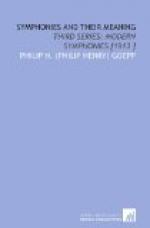At the end of the hymn, on the entering Hosanna! and Hallelujah! we catch the sacred symbol (of seven tones) in the path of the two vocal parts, the lower descending, the higher ascending as on heavenly scale. In the second, optional ending the figure is completed, as the bass descends through the seven whole tones and the treble (of voices and instruments) rises as before to end in overpowering Hallelujah! The style is close knit with the earlier music. A pervading motive is the former brief phrase of aspiration; upon it the angelic groups seem to wing their flight between verses of praise. By a wonderful touch the sigh, that appeared inverted in the plaintive chant of the Purgatorio, is finally glorified as the motive of the bass to the words of exultation.
CHAPTER V
THE SYMPHONIC POEMS OF LISZT
Liszt was clearly a follower of Berlioz in the abandon to a pictorial aim, in the revolt from pure musical form, and in the mastery of orchestral color. If we feel in almost all his works a charming translation of story in the tones, we also miss the higher empyraean of pure fancy, unlimited by halting labels. It is a descent into pleasant, rich pastures from the cosmic view of the lofty mountain. Yet it must be yielded that Liszt’s program-music was of the higher kind that dwells in symbols rather than in concrete details. It was a graphic plan of symbolization that led Liszt to choose the subjects of his symphonic poems (such as the “Preludes” and the “Ideals”) and to prefer the poetic scheme of Hugo’s “Mazeppa” to the finer verse of a Byron. Though not without literal touches, Liszt perceived that his subjects must have a symbolic quality.
Nevertheless this pictorial style led to a revolution in the very nature of musical creation and to a new form which was seemingly intended to usurp the place of the symphony. It is clear that the symphonic poem is in very essence opposed to the symphony. The genius of the symphony lies in the overwhelming breadth and intensity of its expression without the aid of words. Vainly decried by a later age of shallower perception, it achieved this Promethean stroke by the very magic of the design. At one bound thus arose in the youngest art a form higher than any other of human device,—higher than the epic, the drama, or the cathedral.
Bowing to an impatient demand for verbal meaning, Liszt invented the Symphonic Poem, in which the classic cogency yielded to the loose thread of a musical sketch in one movement, slavishly following the sequence of some literary subject. He abandoned sheer tonal fancy, surrendering the magic potency of pure music, fully expressive within its own design far beyond the literal scheme.[A]
[Footnote A: Mendelssohn with perfect insight once declared,—“Notes have as definite a meaning as words, perhaps even a more definite one.”]




